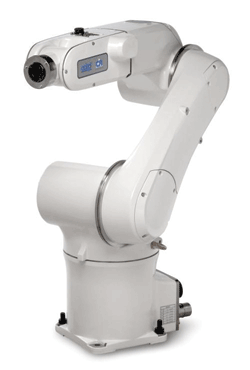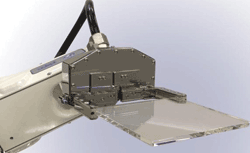What to keep in mind when considering automating your clean-room processes
BY RUSH LaSELLE
Adept Technology, Pleasanton, CA
http://www.adept.com
There’s no doubt that consumer electronics is a huge market with the industry expected to generate over $165 billion in revenue within the U.S. in 2010. The world is in love with consumer electronics. With cell phones, laptops, digital cameras, DVRs, and MP3 players, our lives have changed significantly in the past decade.
While these devices are manufactured to be robust and sustain an occasional slip from our hand, they contain sensitive components requiring precise handling during manufacturing. While certain industries have suffered under a straining economy, the consumer electronic supply chain with its clean-room requirements is growing, and clean-room robotics solutions will play a key part in this growth. This article is an informative guide on considerations to keep in mind when considering automating your clean-room processes.
“The past decade has changed our daily activities in such a way that we cannot imagine a life without the convenience of an iPhone, DVR, digital camera, or our other favorite electronic gadgets,” said Rush LaSelle director of worldwide sales and marketing for Adept Technology, a leading manufacturer of intelligent vision-guided robotics.
“All the images, music and video created by and stored on these gadgets generate tremendous demand for data storage. Studies show that with the increased speed and convenience of file transfer, the average consumer stores these memory intensive files in at least two locations demanding even greater capacity. Industry data also suggests that consumers will purchase at least two hard drives in 10 years, so demand for manufacturing storage devices and memory is growing exponentially.”

So, what do you need to know about clean-room robots and equipment to service this market? How are they different from traditional robots? What about certification, maintenance and those pesky particles? Following is a quick guide to all things clean when it comes to robots.
Clean rooms
By virtue of its name, clean rooms control the level of particle contamination present that can potentially degrade the products being manufactured. Clean rooms are classified according to the number and size of the particles permitted per volume of air. For example, a Class 10 clean room denotes that no more than ten particles of 0.5 µm or larger and zero particles of 5.0 or larger are permitted per square foot of air.
Contaminants can be generated by people, process, facilities and equipment. In order to control contaminants that are invisible to the human eye, the manufacturing cell and in many cases the entire room must be controlled. Robots used in this environment must meet stringent clean room certification requirements to prevent them for acting as a source of contamination.
A robot is a robot is a robot
Well, not exactly. How do clean-room robots differ from their standard counterparts? Much of the hardware used in a clean-room robot is the same as any other robot with the important exception of a combination of sealed covers to prevent particles from escaping the robot, stainless steel hardware, proper non-gassing lubricants and vacuum to evacuate any internally generated particles.
“Robots designed for clean room processes have special considerations for harnesses. From a design standpoint the harness can be a serious particulate generator and a major design challenge for clean applications,” said Scott Klimczak president of CHAD Industries, a pioneer in the area of wafer and substrate handling wafer-level packaging applications. “Understanding the harness requirements and how the robot design will integrate a harness should always be stressed in the robot selection.” (See Fig. 1 ).

Fig. 1. External harness example.
As a matter of practice, materials prone to particle generation are substituted or coated to eliminate the potential for contamination of the manufacturing area and ultimately the components being processed. Depending on your application, clean-room robots can be linear, SCARA, six-axis or delta-type robots, but they all must meet strict clean-room certifications.
Robot certification
Certification is done by counting the number of particles that are generated when the robot is in motion. For this process, the industry employs particle counters that have to be calibrated to meet or exceed the standards set by the National Institute of Standards and Technology (NIST).
In addition to NIST-traceable practices, other standards of particle counter calibration include Japanese Industrial Standard (JIS) B 9921, Light Scattering Automatic Particle Counter, and ASTM F 328-98, Standard Practice for Calibration of an Airborne Particle Counter Using Monodisperse Particles. It is important to fully understand your requirements and the standards they adhere to.
These particle counters are placed in various locations from where particles can enter the environment from the robot to determine the clean-room class. Adept Technologytests robots both internally and through third party testing and certification to ensure integrators and end-users deploy their equipment appropriately to meet manufacturing cleanliness requirements.
“Our robots are designed for high-speed precision applications frequently involving vision guidance. The challenge with this market segment is that it demands careful consideration of not only the components used to develop a highly robust manufacturing process but the manner in which they are integrated has significant impact on the ultimate cleanliness of the cell,” said LaSelle.
“The success of an installation is heavily dependent on tightly integrating engineering and sales teams, Adept has been able to deliver standard and custom clean-room robot solutions tailored to our client’s requirements by investing time and resource in advance of system design to apply lessons-learned from its extensive experience in clean-room applications.”
The right fit
Manufacturers with a clean-room application have numerous options when considering how to manipulate parts and automate their processes. What should you consider when choosing the right robot? Because each company has unique requirements the best approach is to begin by determining answers to the following questions and work directly with the robot manufacturer to select the optimal robot configuration:
• What is the clean-room specification? There are two accepted clean room specifications, the ISO 14644-1 spec and the Fed 209E spec. Confusion and the improper clean specification will greatly impact the design and the cost of the machine.
• What is the required cycle time?
• What are the work envelope requirements and associated interferences?
• What is the tolerance stack-up for the process and ultimate repeatability requirement for the robot?
• Does your robot partner maintain experience in deploying clean-room robots to help guide you in integrating a clean solution?
• Does the robot company have service engineers in the area to support them?
• What is the cell geometry? The cell geometry and the cleanliness requirements are important to define before selecting a robot. Depending on the cell design and the robot style selected, a lower-class robot may be able to be used and still meet the overall system requirements if the system is designed appropriately. For example if you are handling a semiconductor wafer, a robot that can operate under the wafer with a vertical laminar flow of clean air present sweeping the particles away from the product, the ultimate requirement for the robot may be less stringent.
Moving forward
Once you’ve determined which robot best fits your application, installing the clean-room robot requires additional attention to cleanliness. This is where your robot manufacturer and system integrator must be capable of providing direction to ensure a successful installation. The following are a few examples of how deploying a clean robot differs from that of cells in an ambient environment.
“Robots built for Class 1 environments are wrapped in several layers to protect them as they are shipped to the site,” said Kevin Lonie, application sales manager for Clear Automation a Connecticut based automation integrator specializing in the design, engineering, fabrication and installation of integrated robotic and machine vision systems. “Then at the site the equipment is moved through progressively cleaner spaces as the wrapping is wiped down and finally removed before entering its ultimate clean-room destination.”
To avoid spreading particles during installation, the robots and all other accessories should be wiped with clean-room wipes to remove any foreign particles. Once this is done, it is a good practice to connect the robot to the plant’s vacuum system and evacuate the robot for several hours to make sure all particles are purged completely.
In the semiconductor and hard-disk drive industries, it is difficult to avoid having people working in a clean room because of monitoring tasks, nonrobotic material handling steps, etc. But minimizing the number of people working within the clean-room environment allows a manufacturer to better maintain a clean environment.
So it’s fortunate that today’s highly reliable servo-driven robots require minimal maintenance. Industrial robots are being implemented increasingly in clean rooms due to their exceptional mean time between failure when compared to conventional equipment. “Adept clean-room robots use scavenging to remove the particles, so the amount of maintenance is minimal to none,” added LaSelle.
As the need for products manufactured in a clean environment increases, manufacturers will be looking to automation to increase production, reduce cycle times ,and decrease costs all documented benefits of robotic automation. Value exists in fully understanding how to deploy robotics and related technologies in clean-room environments in advance of commissioning to ensure a successful and clean process. ■
Advertisement
Learn more about Adept Technology





